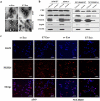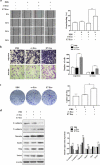Exosomal epidermal growth factor receptor is involved in HPV-16 E7-induced epithelial-mesenchymal transition of non-small cell lung cancer cells: A driver of signaling in vivo
- PMID: 36224722
- PMCID: PMC9559043
- DOI: 10.1080/15384047.2022.2133332
Exosomal epidermal growth factor receptor is involved in HPV-16 E7-induced epithelial-mesenchymal transition of non-small cell lung cancer cells: A driver of signaling in vivo
Abstract
Our previous studies have demonstrated that human papillomavirus (HPV)-16 E7 oncoprotein promoted epithelial-mesenchymal transition (EMT) in non-small cell lung cancer (NSCLC) cells. Moreover, recent studies have found that exosomes can mediate EMT of NSCLC cells and epidermal growth factor receptor (EGFR) is related to the progression of NSCLC. Here, we further investigated the role of exosomal EGFR in HPV-16 E7-induced EMT of NSCLC cells. Our results showed that the exosomes derived from the stable HPV-16 E7-overexpressing A549 and NCI-H460 NSCLC cells (E7 Exo) significantly increased migration, invasion, and proliferation abilities of NSCLC cells as compared with the exosomes derived from empty vector-infected NSCLC cells (ev Exo). Moreover, both in vitro and in vivo results demonstrated that E7 Exo dramatically enhanced EMT of NSCLC cells and promoted the growth of subcutaneous NSCLC xenografts. Additionally, HPV-16 E7 enhanced the expression of EGFR and p-EGFR in both NSCLC cells and exosomes. Furthermore, the inhibition of EGFR activation or exosome secretion suppressed E7 Exo-induced migration, invasion, and EMT of NSCLC. Moreover, 12 kinds of differentially expressed miRNAs between E7 Exo and ev Exo (fold change≥2, P ≤ .05) were screened out, of which 7 miRNAs were up-regulated while 5 miRNAs were down-regulated in A549 E7 Exo. Taken together, our findings suggest that exosomal EGFR is involved in HPV-16 E7-induced EMT of NSCLC cells, which may play a key role in the progression of HPV-related NSCLC.
Keywords: EGFR; EMT; Exosomes; HPV-16 E7; NSCLC.
Conflict of interest statement
No potential conflict of interest was reported by the author(s).
Figures






Similar articles
-
Exosomal EGFR and miR-381-3P Mediate HPV-16 E7 Oncoprotein-Induced Angiogenesis of Non-Small Cell Lung Cancer.Front Biosci (Landmark Ed). 2024 May 15;29(5):189. doi: 10.31083/j.fbl2905189. Front Biosci (Landmark Ed). 2024. PMID: 38812317
-
Overexpression of Human Papillomavirus Type 16 Oncoproteins Enhances Epithelial-Mesenchymal Transition via STAT3 Signaling Pathway in Non-Small Cell Lung Cancer Cells.Oncol Res. 2017 May 24;25(5):843-852. doi: 10.3727/096504016X14813880882288. Epub 2016 Dec 15. Oncol Res. 2017. PMID: 28508744 Free PMC article.
-
The role of monoamine oxidase A in HPV-16 E7-induced epithelial-mesenchymal transition and HIF-1α protein accumulation in non-small cell lung cancer cells.Int J Biol Sci. 2020 Aug 1;16(14):2692-2703. doi: 10.7150/ijbs.46966. eCollection 2020. Int J Biol Sci. 2020. PMID: 32792865 Free PMC article.
-
[Research Progress of the Role of EMT in EGFR-TKIs Resistance of Non-small Cell Lung Cancer].Zhongguo Fei Ai Za Zhi. 2018 Dec 20;21(12):907-911. doi: 10.3779/j.issn.1009-3419.2018.12.08. Zhongguo Fei Ai Za Zhi. 2018. PMID: 30591098 Free PMC article. Review. Chinese.
-
Role of exosomes in non-small cell lung cancer and EGFR-mutated lung cancer.Front Immunol. 2023 Apr 12;14:1142539. doi: 10.3389/fimmu.2023.1142539. eCollection 2023. Front Immunol. 2023. PMID: 37122754 Free PMC article. Review.
Cited by
-
Dark under the Lamp: Neglected Biological Pollutants in the Environment Are Closely Linked to Lung Cancer.Int J Mol Sci. 2024 Mar 7;25(6):3081. doi: 10.3390/ijms25063081. Int J Mol Sci. 2024. PMID: 38542056 Free PMC article. Review.
-
Effects of high-risk human papillomavirus infection on P53, pRb, and survivin in lung adenocarcinoma-a retrospective study.PeerJ. 2023 Jul 26;11:e15570. doi: 10.7717/peerj.15570. eCollection 2023. PeerJ. 2023. PMID: 37520249 Free PMC article.
-
Exosome-Delivered EGFR Induced by Acidic Bile Salts Regulates Macrophage M2 Polarization to Promote Esophageal Adenocarcinoma Cell Proliferation.Onco Targets Ther. 2024 Feb 16;17:113-128. doi: 10.2147/OTT.S437560. eCollection 2024. Onco Targets Ther. 2024. PMID: 38384996 Free PMC article.
-
Epidermal growth factor receptor-dependent stimulation of differentiation by human papillomavirus type 16 E5.Virology. 2024 Feb;590:109952. doi: 10.1016/j.virol.2023.109952. Epub 2023 Dec 12. Virology. 2024. PMID: 38103269 Free PMC article.
References
-
- Wu Z, Tan F, Yang Z, Wang F, Cao W, Qin C, Dong X, Zheng Y, Luo Z, Zhao L, et al. Sex disparity of lung cancer risk in non-smokers: a multicenter population-based prospective study based on China national lung cancer screening program. Chin Med J (Engl). 2022;135(11):1331–1339. doi:10.1097/CM9.0000000000002161. - DOI - PMC - PubMed
Publication types
MeSH terms
Substances
LinkOut - more resources
Full Text Sources
Medical
Research Materials
Miscellaneous
